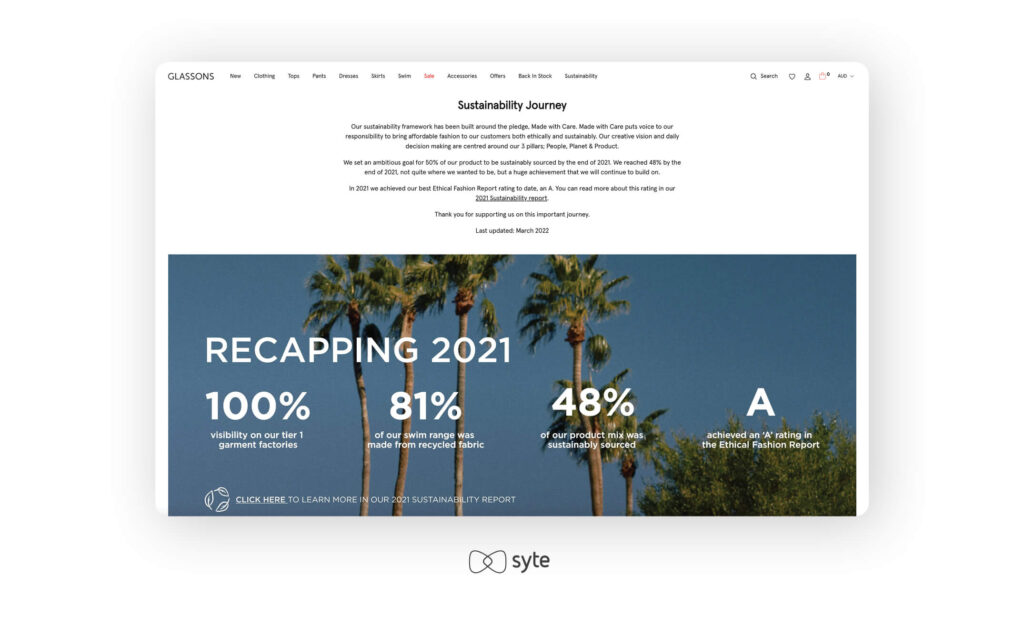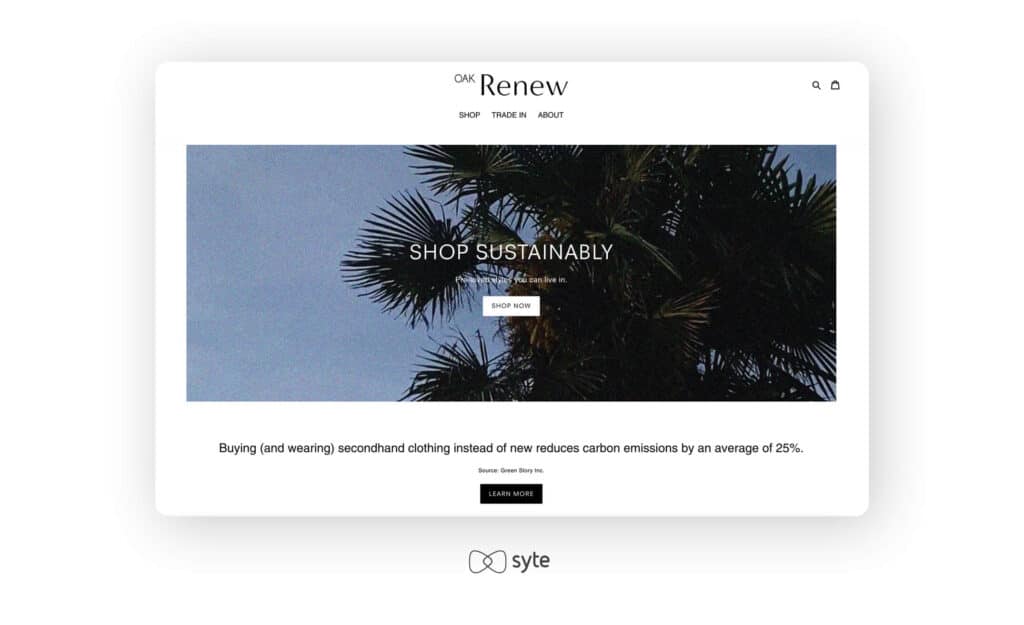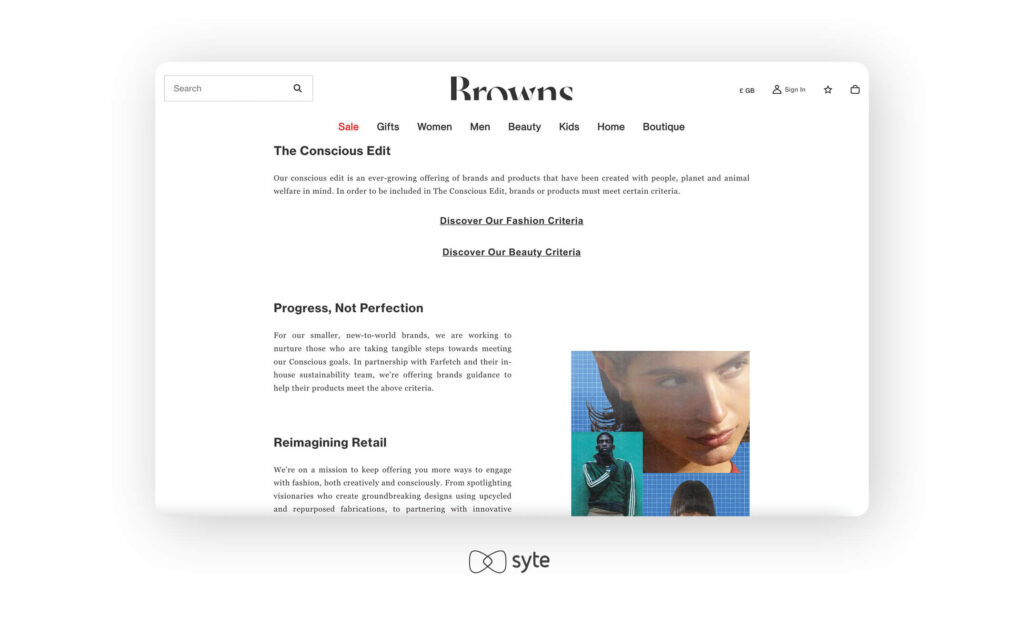Sustainability is connected to a broad range of topics from climate to biodiversity. According to the United Nations (UN) Environment Program (UNEP), the definition of sustainability is: “Improving the quality of human life within the carrying capacity of supporting ecosystems.”
In essence, sustainability means taking only what you need and leaving systems capable of continued existence. Many consumers engage with a brand invested in sustainable practices because they may see it as positive corporate citizenship contributing to society and communities. For many customers, buying from a sustainable brand might be their way to make an eco-conscious impact on the world or to achieve their own sustainability goals through a company’s products and services.
With more customers seeking out sustainable businesses, brands and retailers are looking to the PPP model, which is a triple-bottom-line strategy prioritizing people, planet, and profit.

Sustainability Is Multi-Faceted
There are many layers to sustainable models — from eco packaging and carbon neutrality to circular economies, renewable energy, and social responsibility. According to the UN, the 17 goals of sustainable development include:
No poverty
End poverty in all its forms everywhere.
Zero hunger
End hunger, achieve food security and improved nutrition, and promote sustainable agriculture.
Good health and well-being
Ensure healthy lives and promote well-being for all at all ages.
Quality education
Ensure inclusive and equitable quality education and promote lifelong learning opportunities for all.
Gender equality
Achieve gender equality and empower all women and girls.
Clean water and sanitation
Ensure availability and sustainable management of water and sanitation for all.
Affordable and clean energy
Ensure access to affordable, reliable, sustainable, and modern energy for all.
Decent work and economic growth
Promote sustained, inclusive, and sustainable economic growth, full and productive employment, and decent work for all.
Industry, innovation, and infrastructure
Build resilient infrastructure, promote inclusive and sustainable industrialization, and foster innovation.
Reduced inequalities
Reduce inequality within and among countries.
Sustainable cities and communities
Make cities and human settlements inclusive, safe, resilient, and sustainable.
Responsible consumption and production
Ensure sustainable consumption and production patterns.
Climate action
Take urgent action to combat climate change and its impacts.
Life below water
Conserve and sustainably use the oceans, seas, and marine resources for sustainable development.
Life on land
Protect, restore and promote sustainable use of terrestrial ecosystems, sustainably manage forests, combat desertification, and halt and reverse land degradation and halt biodiversity loss.
Peace, justice, and strong institutions
Promote peaceful and inclusive societies for sustainable development, provide access to justice for all, and build effective, accountable, and inclusive institutions at all levels.
Partnerships for the goals
Strengthen the means of implementation and revitalize the Global Partnership for Sustainable Development.
As you can see, the UN’s goals are far-reaching and all-encompassing as part of its move toward sustainable global change. Brands and retailers can pursue sustainable development as part of their environmental, social, and corporate governance (ESG) in many ways.
This could be in the form of using recycled fabrics or natural materials, re-selling secondhand fashion, jewelry, or home decor pieces, offsetting their carbon emissions, making sure their labor force is treated fairly, and contributing to social causes.

Tips for Sustainability Practices
Stake Your Credibility
Rely on science when it comes to staking your sustainability claims. According to a survey by GWI Zeitgeist based on 12,890 internet users in 9 markets aged 16-64, 46% of respondents reported that scientists are the most influential source impacting their views on sustainability. Following behind, 35% and 31% of survey participants reported friends and family and climate activists, respectively, as being credible sources for sustainability views.
Always back up environmental claims with factual evidence and third-party certification. If you claim that a certain percentage of a product comes from consumer-recycled content, provide supportive data and details.
Also aim to build credible associations with various organizations to build engagement and buy-in from your customer base. Leverage authentic executive voices that can guide and inspire your following. This will help to influence perceptions around your brand and boost your reputational value. Impactful events and forums are another way to lead meaningful conversations about sustainability.
Be Authentic
You don’t need to have all the answers to sustainability, but you should listen, engage back, and openly talk about your journey. Brands and retailers can show customers how they are overcoming obstacles in their sustainability practices and educate and inspire their following in the process.
Many brands fall into promoting a product or service with an environmental feature that simply doesn’t matter. It could be as simple as a misleading label promoting CFC-free ingredients, for example. CFCs have been banned for over 30 years, but companies still add on the designation to appear environmentally friendly. Compared to competitors, they are one and the same and offer no benefit. You should also be mindful of how you brand your sustainability initiatives to avoid greenwashing claims. While a company may be moving towards sustainable alternatives, its efforts should not be marketed as “good for the environment” when its products offer no clear environmental advantage.
Aim for Transparency
Transparency is a window to open and clear information backed by facts and evidence. Transparency is especially important when it comes to tracing a retailer’s supply chain and fair labor across factories around the world.
By using monitoring frameworks and data collection, many companies can be more forthcoming about their production standards and how that impacts their green claims.
Set Realistic Goalposts
Countless brands may talk the talk when it comes to sustainable change, but very few walk the walk. Action speaks louder than words, and consumers can see past the smoke and mirrors. Take Patagonia’s billionaire owner, Yves Chouinard, who is giving away his company in an effort to fight the climate crisis.
To call yourself sustainable, do you only take what you need and leave systems capable of continued existence? Do all of your practices fit into this definition or just one?

Know Your Sustainability Practices
Know your sustainability credentials inside and out and be prepared to get technical and answer questions on several topics related to your environmental, social, and corporate governance (ESG). There are many layers to being a sustainable business that touch upon anything from responsible packaging and waste management to creating a circular economy and recycling.
Vague and over-used designations such as “green and “eco” without specific explanations and proof do not justify their use. If we go back to the 17 UN sustainability goals, could a company focusing on one area such as ending poverty be considered sustainable? What about businesses focused on both reduced inequalities and responsible consumption?
Provide Innovative Solutions
Given the many challenges surrounding climate change, people, businesses, and societies are on the hunt for innovative technology and solutions.
If a brand replaces one inefficiency with a sustainable option, it should ensure it will actually solve the problem. You don’t want to be in a position where one issue is compounded by another in the guise of doing good or doing better.
One example of this is McDonald’s paper straw move from 2019. While the food company aimed to eliminate plastic from its business operations, the paper straws it brought in as part of its new strategy were non-recyclable. Although a step in the right direction, the solution still fell short because it overlooked the wider challenges. In effect, the straws were still contributing to the waste management issue. Instead of finding an alternative that would contribute to a circular economy, the solution was still part of a linear economy.
Wrap-Up
There are many layers to sustainability no matter the vertical. Fashion, jewelry, and home decor brands may decide to focus on one or more areas of sustainable production and consumption as part of their ESG practices.
In any case, being clear about corporate sustainability goals is key to avoiding false claims and greenwashing. From staking credibility and aiming for transparency, there are many ways to lay the foundations for a PPP model and win over customers who value purpose-driven and sustainable products and services.